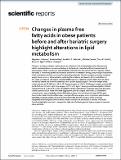Files in this item
Changes in plasma free fatty acids in obese patients before and after bariatric surgery highlight alterations in lipid metabolism
Item metadata
| dc.contributor.author | Hierons, Stephen J. | |
| dc.contributor.author | Abbas, Kazim | |
| dc.contributor.author | Sobczak, Amelie Isabelle Sylvie | |
| dc.contributor.author | Cerone, Michela | |
| dc.contributor.author | Smith, Terry K | |
| dc.contributor.author | Ajjan, Ramzi A. | |
| dc.contributor.author | Stewart, Alan J. | |
| dc.date.accessioned | 2022-09-14T12:30:01Z | |
| dc.date.available | 2022-09-14T12:30:01Z | |
| dc.date.issued | 2022-09-12 | |
| dc.identifier | 281123134 | |
| dc.identifier | 5e86a37b-5f28-4519-9ed7-6dcd37905114 | |
| dc.identifier | 000859184900010 | |
| dc.identifier | 85137705917 | |
| dc.identifier.citation | Hierons , S J , Abbas , K , Sobczak , A I S , Cerone , M , Smith , T K , Ajjan , R A & Stewart , A J 2022 , ' Changes in plasma free fatty acids in obese patients before and after bariatric surgery highlight alterations in lipid metabolism ' , Scientific Reports , vol. 12 , 15337 . https://doi.org/10.1038/s41598-022-19657-9 | en |
| dc.identifier.issn | 2045-2322 | |
| dc.identifier.other | ORCID: /0000-0003-4580-1840/work/119212621 | |
| dc.identifier.uri | https://hdl.handle.net/10023/26008 | |
| dc.description | Funding: This work was supported by the British Heart Foundation (grant ref: FS/20/3/34956). | en |
| dc.description.abstract | Obesity is a complex disease that increases an individual’s risk of developing other diseases and health-related problems. A common feature is dyslipidemia characterized by increased levels of plasma lipids, which include non-esterified fatty acids (NEFAs). The role of NEFAs in obesity-related morbidity is interesting as NEFAs constitute a reservoir of metabolic energy, are principal components of cell membranes and are precursors for signalling molecules. Bariatric surgery promotes sustained weight loss in severely obese patients, reducing the incidence and severity of co-morbidities. In this study we measure changes in circulating NEFA species in plasma samples taken from 25 obese individuals before and 9 months after Roux-en-Y gastric bypass surgery. The mean weight of the cohort reduced by 29.2% from 149.0±25.1 kg pre-surgery to 105.5±19.8 kg post-surgery and the BMI by 28.2% from 51.8±6.3 kg/m2 pre-surgery to 37.2±5.4 kg/m2. Mean glycated haemoglobin (HbA1c) reduced from 6.5±1.3% to 5.5±0.5%, consistent with the intervention leading to improved glycaemic control, particularly in those who were dysglycemic prior to surgery. Total and LDL cholesterol concentrations were markedly reduced following surgery. Concentrations of seven NEFAs were found to decrease 9 months after surgery compared to pre-surgery levels: myristate, palmitoleate, palmitate, linoleate, oleate, stearate and arachidonate. Bariatric surgery led to increased lipogenesis and elongase activity and decreased stearoyl-CoA desaturase 1 activity. This study thus highlights metabolic changes that take place following gastric bypass surgery in severely obese patients. | |
| dc.format.extent | 10 | |
| dc.format.extent | 2493207 | |
| dc.language.iso | eng | |
| dc.relation.ispartof | Scientific Reports | en |
| dc.subject | QP Physiology | en |
| dc.subject | RD Surgery | en |
| dc.subject | NDAS | en |
| dc.subject | SDG 3 - Good Health and Well-being | en |
| dc.subject | MCC | en |
| dc.subject.lcc | QP | en |
| dc.subject.lcc | RD | en |
| dc.title | Changes in plasma free fatty acids in obese patients before and after bariatric surgery highlight alterations in lipid metabolism | en |
| dc.type | Journal article | en |
| dc.contributor.institution | University of St Andrews. Cellular Medicine Division | en |
| dc.contributor.institution | University of St Andrews. School of Medicine | en |
| dc.contributor.institution | University of St Andrews. School of Biology | en |
| dc.contributor.institution | University of St Andrews. Sir James Mackenzie Institute for Early Diagnosis | en |
| dc.contributor.institution | University of St Andrews. Biomedical Sciences Research Complex | en |
| dc.contributor.institution | University of St Andrews. Institute of Behavioural and Neural Sciences | en |
| dc.identifier.doi | https://doi.org/10.1038/s41598-022-19657-9 | |
| dc.description.status | Peer reviewed | en |
This item appears in the following Collection(s)
Items in the St Andrews Research Repository are protected by copyright, with all rights reserved, unless otherwise indicated.

